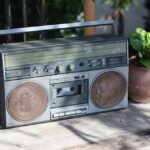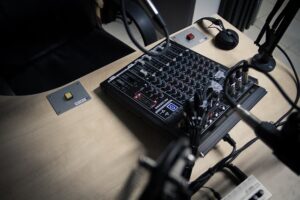When assembling the amplifier, it is advisable to use mica capacitors as constant capacitors (in addition to electrolytic capacitors). For example, the CSR type, as in the figure below.
Transistors MP40A can be replaced by transistors MP21, MP25, MP26. Transistor GT402G – for GT402B; GT404G – for GT404V;
GT806 output transistors can be assigned any letter index. I do not recommend using low-frequency transistors like P210, P216, P217 in this circuit, because at frequencies above 10 kHz they fail here (noticeable distortion), apparently due to the lack of high frequency current amplification.
The radiator area for the output transistors must be at least 200 cm2, for the pre-output transistors at least 10 cm2.
It is convenient to make GT402 type transistor radiators from copper (brass) or aluminum plate 0,5 mm thick, size 44×26,5 mm.
The plate is cut along the lines, then a tube is formed from this part using any suitable cylindrical mandrel (such as a drill bit) for this purpose).
The ring is made of 0.5-1.0 mm steel wire. Instead of the ring you can use a strip of copper wire.
Now it remains to bend the bottom side ears to fix the heatsink to the transistor body and bend the engraved feathers to the right angle.
A similar heatsink can also be made from a copper pipe with a diameter of 8 mm. Cut off a piece of 6…7 cm, cut the tube along its entire length from one side. Then cut the tube into 4 parts by half length, fold these parts in the shape of petals and place them tightly on the transistor.
Since the diameter of the transistor body is about 8.2 mm, the slit along the length of the tube will make it fit tightly to the transistor and will be held on the transistor body by its elastic properties.
Resistors in the emitters of the output stage: wire-wound 5W or MLT-2 type 3 Ohm, 3 pieces in parallel. I do not recommend to use imported films, they burn out instantly and unnoticeably, which leads to failure of several transistors at once.
Some measurements
After adjusting the DC modes I connected an oscilloscope and an oscilloscope to the amplifier. It gave a signal. At the output the signal limiting (blue) occurs at an amplitude of about 12 volts with a load of 4 ohms, which corresponds to an output power of 18 watts.
The amplitude of the input signal (yellow) is about 1.5 volts. That is, the amplifier has a sensitivity of about 1 volt RMS.
I liked the bandwidth as well. There is almost no drop from 15 Hz to 60 kHz. If we removed the 100 pF capacitors from the feedback loop and the input, it would probably be even wider.
What you need! This is exactly the output level of the computer sound card that will be used as the main signal source.
I checked the maximum current consumption of the amplifier. When a rectangular signal with a frequency of 10 kHz and an amplitude of 1.5 V is applied to the input, the amplifier draws just under 2 A from the power supply.
It’s time for the crash test. I put 1.5 A fuses in the cartridges, set the maximum possible current limitation on the power supply (I have 5 A), and applied a 10 kHz sine to the input. I bring the power up to the maximum when the signal is already limited. Then I use a screwdriver to short the load. The fuse blows. I replace the fuse with a new one, turn the amplifier back on: the output transistors are intact! After blowing three fuses (two on one amplifier board and one on the other), I decided that the reliability test was passed, and I could now proceed to finally reassemble the amplifier in its case.
First turn on, setting up the amplifier it is time to turn on and test the assembled amplifiers for the first time. I did this with a limited current laboratory power supply.
First I set the supply voltage to 15V. I set the quiescent current of the amplifier to 100 mA, balanced the output so that it had exactly half the supply voltage, then began to gradually increase the supply voltage to the desired 30 volts.
During this operation I had to change the ratings of some resistors slightly, because as the supply voltage increased, the quiescent current began to increase dramatically. Without the current-limiting power supply, I probably would have lost more than one pair of output transistors. But then it all worked out.
Assembling the Amp
The circuit was built on a 40x50mm board, which can be made by LUT. Below is a photo of the finished white tin.
Now we can begin to install the parts. First of all the resistors are placed on the board, then the capacitors and the transistors. Keep in mind that germanium transistors, unlike silicon transistors, are much more sensitive to overheating.
Powerful output transistors get hot when working in large volumes, so it is recommended to install them on a radiator (if the transistor body has such a possibility) and to connect them to the board.
After installing all the parts on the board is left to solder the cables for power, signal source and output to the speaker. The final stage of assembly is to wash off the flux residue from the board, check the correct assembly, and loop the adjacent rails for short circuits.
First power-up and tuning
The germanium amplifier requires a quiescent current setting, which is set by diode D1. The first thing to do is to apply voltage to the circuit by plugging an ammeter into the gap of the power cable. When there is no input signal, the circuit should draw about 20-50 mA. The higher the quiescent current, the more heated the output transistors are, but this has a positive effect on sound quality. If the quiescent current is too low, the sound becomes unintelligible, there is squeal and hoarseness. You can increase the current by adding one or more diodes in series with D1. In my case I had to add two more diodes to get an acceptable sound quality.
Such amplifier circuits with germanium transistors were widely used in old turntables, tape recorders and radios, so they are sure to please all lovers of antiquity. The output power is about 5-10 watts with a heatsink, so a single-head amplifier will be enough to play the whole room. Happy building!















